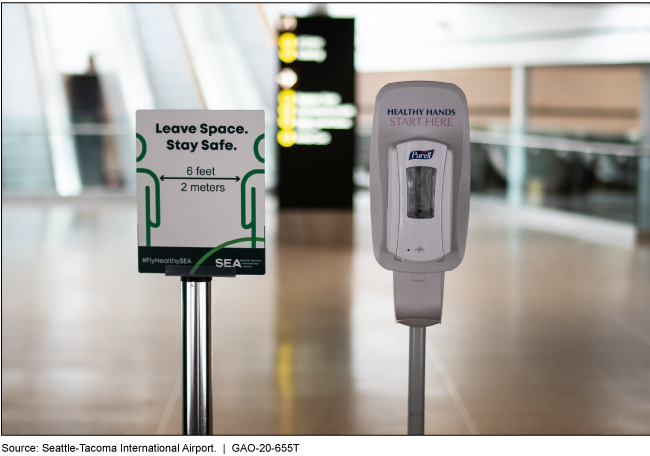Air Travel and Communicable Diseases: Status of Research Efforts and Action Still Needed to Develop Federal Preparedness Plan
Fast Facts
COVID-19 is only the latest disease to raise concerns over contagions spread through air travel. In 2015, during the Ebola epidemic, we recommended that the Department of Transportation develop a comprehensive national aviation-preparedness plan for communicable disease outbreaks.
However, it has yet to do so. Such a plan could have improved coordination between public-health and aviation sectors during COVID-19 to address issues like passenger screening.
We also found that FAA has conducted limited research on disease transmission during air travel or in airports. We earlier recommended FAA improve how it sets research priorities.

Hand sanitizer and sign saying "Leave Space. Stay Safe" at airport
Highlights
What GAO Found
The United States still lacks a comprehensive plan for national aviation preparedness to limit the spread of communicable diseases through air travel. In December 2015 during the Ebola epidemic, GAO recommended that the Department of Transportation (DOT) work with relevant stakeholders, such as the Department of Health and Human Services (HHS), to develop a national aviation-preparedness plan for communicable disease outbreaks. GAO concluded that the absence of a national plan undermined the ability of the public-health and aviation sectors to coordinate on a response or to provide consistent guidance to airlines and airports. Moreover, Annex 9 to an international aviation treaty to which the United States is a signatory contains a standard that obligates member states to develop such a plan. DOT is now confronting an even more widespread public health crisis—the Coronavirus Disease (COVID-19) global pandemic—without having taken steps to implement this recommendation. Not only could such a plan provide a mechanism for the public-health and aviation sectors to coordinate to more effectively prevent and control a communicable disease threat, it could also help minimize unnecessary disruptions to the national aviation system, disruptions that to date have been significant. Some aviation stakeholders have publicly highlighted the resulting piecemeal approach to adopting standards during the response to COVID-19, such as various airline and airport policies regarding facemasks, as demonstrating the need for a more coordinated response. The existence of a national plan might have reduced some of the confusion among aviation stakeholders and passengers. While DOT agrees that a national aviation preparedness plan is needed, the agency continues to suggest that HHS and the Department of Homeland Security have responsibility for communicable disease response and preparedness planning. GAO continues to believe that DOT is in the best position to lead this effort given its oversight responsibilities and ties with relevant aviation stakeholders.
The Federal Aviation Administration (FAA) has sponsored limited federal research into disease transmission onboard aircraft and in airports. FAA's research goals focus on areas like improving airport operations and air space management, and developing new technologies, which FAA has aligned to DOT's strategic goals related to safety, infrastructure, and innovation. Based on prior work and interviews with FAA officials, GAO found that FAA's research in cabin safety for crew and passengers does not focus on disease transmission. For example, according to FAA officials, ongoing research that most closely relates to disease contamination is research related to monitoring the quality of “bleed air,” which is outside air that is drawn through jet engines into an aircraft cabin. In 2017, GAO found that FAA could be more strategic in how it develops its research and development (R&D) portfolio, chiefly in identifying long-term research needs and explaining how FAA selects projects. Of the three recommendations GAO made in that report to improve FAA's management of its R&D portfolio, FAA fully addressed one, issuing guidance in 2018 on prioritizing and selecting R&D projects. While FAA has made some progress addressing GAO's recommendations on research portfolio development and reporting, further attention to these recommendations could help ensure that FAA strategically identifies research priorities across the agency.
Why GAO Did This Study
The transmission of COVID-19 has been greatly aided by air travel. In light of the pandemic and warnings about the risks of air travel, U.S. passenger airline traffic fell by 96 percent in April 2020 as compared to April 2019. COVID-19 is only the latest communicable disease threat to raise public health concerns regarding the spread of contagion through air travel. Ensuring that the United States is prepared to respond to disease threats from air travel, as well as conducting the necessary research to reduce the risks of contagion, are two vital responsibilities of the federal government.
This statement provides information on (1) the U.S. aviation system's preparedness to respond to communicable disease threats and (2) FAA's management of its R&D portfolio, including the extent to which disease transmission on aircraft and at airports has been the focus of FAA research. This statement is based on GAO-16-127 issued in December 2015 and GAO-17-372 issued in April 2017. GAO conducted updates to obtain information on the actions agencies have taken to address these reports' recommendations.
Recommendations
GAO made several recommendations in its prior work, including that DOT develop a comprehensive national aviation-preparedness plan, and that FAA identify long-term R&D priorities, among other things. Progress has been made in addressing some of the recommendations. Continued attention is needed to ensure that the remainder of these recommendations are addressed.
